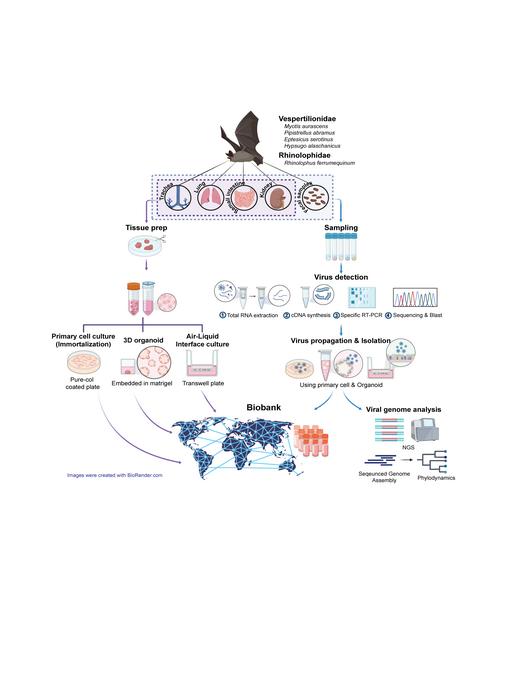In a groundbreaking advancement poised to revolutionize the study of zoonotic viruses, researchers at the Institute for Basic Science (IBS) in Korea have developed an unprecedented bat organoid platform that closely mimics the physiology of bats’ multiple organs. This innovative system enables scientists to probe the complex interactions between bats and the myriad of viruses they harbor, shedding light on viral behavior within these unique mammalian hosts. Bats are notorious reservoirs for viruses that have spilled over into human populations, causing devastating pandemics and outbreaks such as COVID-19, MERS, influenza A, and hantavirus. However, until now, the scientific community lacked the sophisticated tools necessary to study these viruses in their natural bat cellular environments.
The novel bat organoid platform comprises three-dimensional “mini-organs” cultivated from four distinct tissues—trachea, lungs, kidneys, and small intestines—sourced from five species of insectivorous bats commonly found across Korea and Europe. Unlike previous models limited to single-organ studies of tropical fruit bats, this new approach incorporates multiple species and organs, enabling a holistic investigation of virus-host interactions. By faithfully recapitulating bat organ physiology in the laboratory, these organoids provide a highly relevant biological context for studying viral pathogenesis, immune responses, and transmission dynamics.
Key to the significance of this research is the researchers’ ability to explore organ- and species-specific differences in viral infection and replication. Testing viruses such as SARS-CoV-2, MERS-CoV, influenza A, and hantaviruses across this diverse panel revealed heterogenous viral tropism. Some viruses exhibited restricted infection patterns, thriving in certain bat organs but failing to replicate in others, or infecting some species more efficiently than others. These differential infection patterns help decode the enigmatic mechanisms governing why some bat-borne viruses successfully cross species barriers and invade human populations while others remain confined within bat reservoirs.
The organoid platform not only advances our understanding of viral tropism but also opens new avenues for antiviral drug testing within a physiologically relevant bat cellular environment. By adapting the 3D organoids into two-dimensional monolayers, scientists can perform high-throughput antiviral screening, yielding more accurate predictions of drug efficacy compared to conventional cell culture systems. For instance, preliminary assessments of Remdesivir demonstrated the platform’s capability to evaluate therapeutics targeting bat-borne viruses, enhancing translational potential for managing future outbreaks.
Another notable breakthrough of this research is the successful isolation and characterization of two novel bat viruses—an orthoreovirus and a paramyxovirus—directly from wild bat fecal samples. Remarkably, the paramyxovirus was uncultivable in standard immortalized cell lines but proliferated robustly within the bat organoids. This finding underscores the platform’s value for isolating and studying elusive pathogens that conventional virology techniques fail to capture, providing an essential resource for comprehensive virus discovery and surveillance.
The team also delved into the unique immunological landscape of bats, revealing that innate immune responses to viral infections varied not only between species but also among distinct organs of the same bat. Such nuanced immunological heterogeneity potentially contributes to bats’ exceptional ability to coexist with numerous viruses asymptomatically. Understanding these immune mechanisms at the organ-specific level is critical for identifying viral persistence strategies and host tolerance pathways, which may inform novel approaches to antiviral therapies.
Beyond advancing fundamental virology, the establishment of this comprehensive bat organoid biobank promises to transform global pandemic preparedness. By standardizing and scaling the cultivation of bat organoids across multiple species and tissues, the platform facilitates a globally accessible repository for researchers aiming to identify emerging bat-origin viruses and evaluate antiviral candidates rapidly. Such a collaborative resource integrates viral surveillance with functional experimentation, thus bridging a critical gap in zoonotic virus research.
This initiative also aligns with broader international biosecurity priorities by enabling detailed investigations into the molecular determinants that govern viral spillover events. Through comparative genomic and phenotypic analyses supported by the organoid models, scientists can construct refined predictive frameworks to assess the pandemic potential of newly discovered bat viruses, ultimately informing public health interventions and policy decisions.
Dr. Koo Bon-Kyoung, Director of IBS Center for Genome Engineering, emphasized the transformative impact of this platform: “Reconstructing bat organ physiology in vitro empowers us to dissect zoonotic virus biology with unprecedented precision, a vital step toward mitigating future outbreaks before they reach humans.” Senior researcher Kim Hyunjoon echoed this, highlighting the platform’s unique capability to integrate viral isolation, infection studies, and drug testing within a singular, biologically relevant system that surpasses traditional methodologies.
Looking ahead, the research consortium envisions expanding the biobank to encompass additional bat species aligned with key geographic hotspots of viral emergence. This global effort aims to provide a comprehensive atlas of bat virology and immune interactions, positioning the bat organoid platform as an indispensable asset for both national and international disease control agencies, including the World Health Organization (WHO).
In summary, this unparalleled bat organoid platform represents a major leap forward in understanding and counteracting zoonotic diseases. By enabling the precise study of viruses in bat-specific tissues from multiple species, it will accelerate the discovery of novel pathogens, elucidate viral infection mechanisms, and expedite therapeutic development. This work not only enhances our scientific toolkit but also constitutes a proactive measure to bolster global readiness against future pandemics that originate at the animal-human interface.
Subject of Research: Animal tissue samples
Article Title: Diverse bat organoids provide pathophysiological models for zoonotic viruses
News Publication Date: 15-May-2025
Web References: http://dx.doi.org/10.1126/science.adt1438
References: 10.1126/science.adt1438
Image Credits: Institute for Basic Science
Keywords: Organoids, Organ cultures, Tissue cultures, Laboratory procedures, Research methods, Life sciences, Cell biology, Virology, Viral infections, Viruses
Tags: advancements in infectious disease studybat organoid platformbat physiology modelingimmune response analysis in batsinsectivorous bat species researchorganoid technology in virologypandemic preparedness innovationsthree-dimensional organ modelstransmission dynamics of zoonotic diseasesviral pathogenesis studiesvirus-host interactions in batszoonotic virus research





